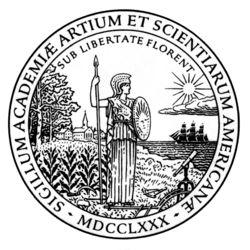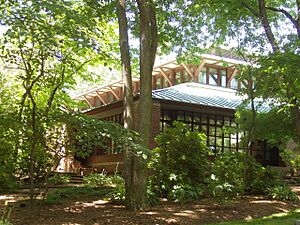American Academy of Arts and Sciences facts for kids
 |
|
| Abbreviation | The American Academy; The Academy |
|---|---|
| Formation | May 4, 1780 |
| Type | Honorary society and independent research center |
| Headquarters | Cambridge, Massachusetts, U.S. |
|
Membership
|
5,700+ active members |
|
President
|
Laurie L. Patton |
| Subsidiaries | Daedalus |

The American Academy of Arts and Sciences (often called The Academy) is one of the oldest and most respected groups for smart people in the United States. It was started in 1780 during the American Revolution. Important leaders like John Adams and John Hancock helped create it.
The Academy is located in Cambridge, Massachusetts. People become members by being nominated and then elected by others. The Academy publishes a magazine called Dædalus four times a year. This magazine shares new ideas and research.
The Academy also does research on important public topics. Laurie L. Patton became the President of the Academy in January 2025.
Contents
History of the Academy
The Academy was officially started by the state of Massachusetts on May 4, 1780. Its goal was to "cultivate every art and science." This meant they wanted to encourage all kinds of learning and discovery. They hoped this would help a free and independent country grow.
The first 62 members were important people from politics, business, and different jobs. In 1781, the Academy chose its first new members. These included famous figures like Benjamin Franklin and George Washington. Some international members were also chosen.
The Academy started publishing its findings in 1785. Later, in the 1950s, they launched their journal Daedalus. This showed their interest in wider intellectual and social topics.
Research and Programs
Since the mid-1900s, doing independent research became a main focus for the Academy. For example, in the late 1950s, they started looking into arms control. This means how to control weapons to prevent wars.
The Academy also helped create the National Humanities Center in North Carolina. This center supports studies in subjects like history, literature, and philosophy. In the late 1990s, the Academy made a new plan. They decided to focus on four main areas:
- Science, technology, and global safety
- Social policies and education
- Humanities and culture
- Education
In 2002, the Academy started a program for visiting scholars. These scholars come to the Academy to do research. Over 75 universities across the country support this program. The Academy has also given out many awards and prizes over the years.
Academy Projects
The Humanities Indicators
The Academy has a special project called The Humanities Indicators. This project collects data about the humanities. The humanities include subjects like history, literature, and art.
This project helps researchers, teachers, and museums. It gives them tools to understand things like:
- How humanities are taught in schools
- How many students study humanities in college
- Where funding for humanities comes from
- How the public understands the humanities
This project is similar to the Science and Engineering Indicators. That project collects data about science and engineering.
Academy Membership
People become members of the Academy by being nominated and elected by their peers. This means other members choose them. From the very beginning, members have included scientists, scholars, writers, and artists. They also include people from many different jobs and public life.
Over 10,000 people have been elected as members throughout the Academy's history. Some famous past members include John Adams, Thomas Jefferson, and Jonas Salk. International honorary members have included Albert Einstein and Charles Darwin.
Maria Mitchell, an astronomer, was the first woman elected to the Academy in 1848. Today, there are over 5,700 active members. These members are from the United States and around the world. Many Academy members have won major awards. More than 250 have won the Nobel Prize, and over 60 have won the Pulitzer Prize.
Many members are connected to top universities. For example, over 1,400 members have been linked with Harvard University.
Membership Categories
As of 2023, members are divided into five main groups, called classes. Each class has different specialties.
- Class I – Mathematical and physical sciences: This includes subjects like Mathematics, Physics, Chemistry, Astronomy, and Computer sciences.
- Class II – Biological sciences: This covers areas like Biochemistry, Cellular biology, Neurosciences, and Medical sciences.
- Class III – Social and behavioral sciences: This group includes Psychological sciences, Economics, Political science, Law, and Education.
- Class IV – Arts and humanities: This class focuses on Philosophy, History, Literature, Visual arts, and Performing arts.
- Class V – Public affairs, business, and administration: This includes leaders in Journalism, Business, Education, and public policy.
Presidents of the Academy
The Academy has had many presidents since it was founded in 1780. Some notable past presidents include John Adams and his son John Quincy Adams. The current president is Laurie L. Patton.
See also
 In Spanish: Academia Estadounidense de las Artes y las Ciencias para niños
In Spanish: Academia Estadounidense de las Artes y las Ciencias para niños
- American Philosophical Society
- National Academy of Engineering
- National Academy of Medicine
- National Academy of Sciences
- List of American Academy of Arts and Sciences members

